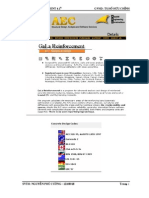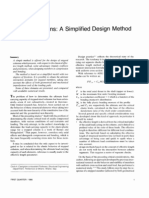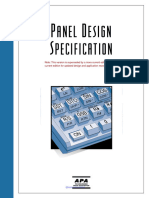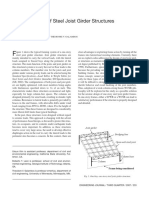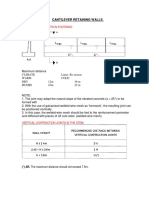Highter Anders 1985 PDF
Highter Anders 1985 PDF
Uploaded by
Ernesto Fidel Mandujano CardenasCopyright:
Available Formats
Highter Anders 1985 PDF
Highter Anders 1985 PDF
Uploaded by
Ernesto Fidel Mandujano CardenasOriginal Title
Copyright
Available Formats
Share this document
Did you find this document useful?
Is this content inappropriate?
Copyright:
Available Formats
Highter Anders 1985 PDF
Highter Anders 1985 PDF
Uploaded by
Ernesto Fidel Mandujano CardenasCopyright:
Available Formats
See discussions, stats, and author profiles for this publication at: https://www.researchgate.
net/publication/248877698
Dimensioning Footings Subjected to Eccentric Loads
Article in Journal of Geotechnical Engineering · May 1985
DOI: 10.1061/(ASCE)0733-9410(1985)111:5(659)
CITATIONS READS
26 709
2 authors, including:
John Anders
Montrose Environmental Group, Inc.
2 PUBLICATIONS 28 CITATIONS
SEE PROFILE
All content following this page was uploaded by John Anders on 16 January 2020.
The user has requested enhancement of the downloaded file.
DIMENSIONING FOOTINGS SUBJECTED
TO ECCENTRIC LOADS
By William H. Highter, 1 M. ASCE and John C. Anders 2
Downloaded from ascelibrary.org by MARRIOTT LIB-UNIV OF UT on 11/22/14. Copyright ASCE. For personal use only; all rights reserved.
INTRODUCTION
Eccentric loading of shallow foundations occurs w h e n a vertical load
is applied at a location other than the centroid of a footing, or a footing
is subjected to a m o m e n t as well as a concentric vertical load. In the
latter case, the vertical load can be transferred to a n eccentric position
defined by
M. , Mb
and ei =
eb = — ~p~ W
in which P = vertical load; Mh and M i = m o m e n t s about the short and
long axes of a rectangular footing, respectively; and eh a n d ex = eccen-
tricities of the load P about the centroid of the footing in the direction
of the short and long axes, respectively.
Analysis of an eccentrically loaded footing requires consideration of
the structural design a n d bearing capacity. The approach usually used
in structural design is to assume that the contact pressure at the bottom
of the footing is planar. If the eccentric loading is within the kern of the
footing, the contact pressure distribution can be obtained from the flex-
ural formula. If, however, t h e eccentric loading is outside the kern, a
trial and error graphical procedure m u s t be used, based on: (1) The as-
sumption that the contact pressure varies linearly from zero at the neu-
tral axis to a maximum at a point farthest from the neutral axis; a n d (2)
the requirement that t h e resultant of the soil contact pressure m u s t co-
incide with the point of application of the applied load, P. Teng (5) p u b -
lished a table (for circular footings) and a figure (for rectangular footings)
that gave factors from which the maximum contact stress could be cal-
culated. Even with this, the structural design of footings subjected to
eccentric load is an iterative procedure. More recently, Jarquio and Jar-
quio (1) presented a direct m e t h o d of designing a rectangular footing
w h e n the maximum contact pressure is specified and the contact stresses
are compressional everywhere beneath the footing, i.e., the flexural for-
mula is applicable.
The approach often used to determine the bearing capacity of a footing
subjected to an eccentric loading is based on Meyerhof's (2) observation
that "at the ultimate bearing capacity of the foundation the distribution
of contact pressure is not even approximately linear, and a very simple
solution of the problem is obtained by assuming that the contact pres-
'Prof. of Civ. Engrg., Univ. of Tennessee, Knoxville, Tenn. 37996.
2
Geotechnical Engr., Soil and Material Engrs., Inc., Blountville, Tenn. 37617.
Note.—Discussion open until October 1, 1985. To extend the closing date one
month, a written request must be filed with the ASCE Manager of Journals. The
manuscript for this paper was submitted for review and possible publication on
March 27, 1984. This paper is part of the Journal of Geotechnical Engineering,
Vol. I l l , No. 5, May, 1985. ©ASCE, ISSN 0733-9410/85/0005-0659/$01.00. Paper
No. 19696.
659
J. Geotech. Engrg. 1985.111:659-665.
sure is identical to that . . . for a centrally loaded foundation but of
reduced width." Meyerhof suggested that when there is two-way ec-
centricity, the procedure be extended "by finding the minimum effective
contact area . . . such that its centroid coincides with that of the load."
Meyerhof's approach is preferable to an alternative method of deter-
Downloaded from ascelibrary.org by MARRIOTT LIB-UNIV OF UT on 11/22/14. Copyright ASCE. For personal use only; all rights reserved.
mining bearing capacity of eccentrically loaded footings which considers
maximum contact pressure because experimental evidence supports the
concept of a reduced, effective area; furthermore, Meyerhof's experi-
ments showed that the alternative method gives rather conservative re-
sults for clays. For sands, the results are "reasonable for small eccen-
tricities but unsafe for greater eccentricities."
Having calculated the reduced or effective area, A', of a footing sub-
jected to an eccentric load using the Meyerhof procedure, and defining
L' as the longest dimension of the effective area, the effective width, B',
is then calculated from
A'
B (2)
'=F
The effective area is thus assumed to be rectangular.
In analysis, these effective dimensions are then used in the well-known
bearing capacity equation (3,4) to determine the allowable load, Q, on
the footing:
/ B' \A'
Q = \kcdcicCNc + X^d^yDfN,, + \ydyiy — yNyJ — (3)
in which FS = an appropriate factor of safety; Nc, Nq and Ny = bearing
capacity factors for a continuous footing; 7 = unit effective weight of the
soil; C = undrained shear strength of the soil; \ c , X, and \y = shape
factors used for other than continuous footings; dc, dq and dy = factors
used to account for the increase in bearing capacity due to the strength
of the soil above the foundation level; ic, /', and iy = factors used to
account for the inclination of a concentric load; and Df = minimum dis-
tance from ground level to the bottom of the footing. Note that since
the last term in Eq. 3 (which contains B') vanishes for cohesive soil (Ny
= 0) but not for cohesionless soils, the effect of eccentricity is more pro-
nounced for footings on sands than on clays.
In design, determining the bearing capacity of a footing from Eq. 3 is
always an iterative procedure because, while the design objective is to
dimension the footing, the shape factors depend on the relative dimen-
sions of the footing. When the loading is eccentric, the design is more
cumbersome because the process of finding the reduced effective width
and area of a footing subjected to an eccentric load is time-consuming.
The eccentricity of the applied load is easily determined from vertical
load and moment data, but since determining the dimensions of the
footing is the purpose of the design procedure, the reduced (effective)
dimensions cannot be found directly. To aid the engineer, normalized
design charts for determining effective dimensions have been prepared
and are presented here. The design process necessarily remains itera-
tive, but the design charts will enable the engineer to design circular or
660
J. Geotech. Engrg. 1985.111:659-665.
rectangular footings subjected to eccentric loads much more easily and
faster than was previously possible.
ONE-WAY ECCENTRICITY
Downloaded from ascelibrary.org by MARRIOTT LIB-UNIV OF UT on 11/22/14. Copyright ASCE. For personal use only; all rights reserved.
For rectangular footings subjected to one-way eccentricity, where the
load is applied along a line joining the midpoints of opposite sides of
the footing, the effective foundation dimensions are
B' = B-2eb and L'= L when ex = 0 [Fig. 1(a)] (4)
and B' = B and L' = L - 2et when eb = 0 [Fig. 1(b)] (5)
Because of symmetry, eccentric loading on a circular footing is always
one-way. Normalized solutions for A'/R2 and B'/R are shown in Fig. 2
as a function of Er/R in which E, = eccentricity of the load and R =
radius of the footing. To use this graphical solution, enter Fig. 2 with
the eccentricity Er (calculated from load and moment data) and a known
footing radius. The effective dimensions A' and B' can then be deter-
mined and used in the bearing capacity equation to analyze the bearing
?3J
2«l
(W.
FIG. 1.—(a) Single Eccentricity (ex = 0); (ft) Single Eccentricity (eb = 0)
• H
ff
1 n \
\
R*
\
\
\ A1 L' i erv/A
"
\
\
\
\
\
B'
R!
\
\
\ s
i
1.0 \ s
\
\ N
\,
0.0
0.0 0.1 02 0.3 0.4 0.5 0.6 0.7 0.8 0.9 1.0
FIG. 2.—Normalized Effective Dimensions for Circular Footing
661
J. Geotech. Engrg. 1985.111:659-665.
capacity of the footing. In design, the procedure is iterative and radii
are assumed until a footing having an acceptable safety factor is ob-
tained.
Downloaded from ascelibrary.org by MARRIOTT LIB-UNIV OF UT on 11/22/14. Copyright ASCE. For personal use only; all rights reserved.
TWO-WAY ECCENTRICITY
When the eccentricity is in both directions, the problem is more com-
plex because the designer does not know the shape of the effective area.
For rectangular footings, there are four possible cases, depending on the
magnitudes of ei/L and eb/B. In developing these figures, the eccentric
load was assumed to act in the first quadrant of the rectangular footing.
Case 1.—In Case 1, e-^/L S 1/6 and eb/B g 1/6, and the effective area
is triangular (Fig. 3). The normalized dimensions of the effective area
can be calculated directly:
B1_1.5-3e„ Li = L5_-_3e i
B B L L
The effective area A' can be calculated from Bi and L j . Letting L'
equal the larger of Bx and Li, B' is then calculated using Eq. 2. In lieu
of Eq. 6, the uppermost curves of Figs. 4 and 5 can be used to find
Li/L as a function of ej/L, and B1/B as a function of eb/B, respectively,
for Case 1.
Case 2.—In Case 2, eb/B < 1/6 and 0 < ex/L < 0.5. Entering Fig. 4
with e : /L and eb/B, locate et/L on the ordinate and move to the right
until the first radial line corresponding to eb/B is encountered. The ab-
scissa value corresponding to this point is L2/L. Moving further to the
right across the broken line, a second radial line corresponding to eb/B
will be found. The value on the abscissa corresponding to this point is
Lx/L. The effective area A' can then be calculated knowing L-i and L 2 ;
L' is the larger of Lx and L 2 , and B' is found from Eq. 2.
Case 3.—In Case 3, e%/L < 1/6 and 0 < eb/B < 0.5. this case is similar
\
X//®-
l
/.
FIG. 3.—Case 1: Effective Area (eb/B g 1/6 and e,/L £ 1/6)
662
J. Geotech. Engrg. 1985.111:659-665.
Downloaded from ascelibrary.org by MARRIOTT LIB-UNIV OF UT on 11/22/14. Copyright ASCE. For personal use only; all rights reserved.
FIG. 4.—Case 2: Normalized Effective Dimensions (and LJL for Case 1)
FIG. 5.—Case 3: Normalized Effective Dimensions (and BJB for Case 1)
to Case 2 except that the base of the trapezoidal effective area is L (Fig.
5). Bx and B2 are found from Fig. 5; A' is then calculated knowing Bx
and B 2 ; L' = L; and B' is found from Eq. 2.
Case 4.—In Case 4, eb/B < 1/6 and eJL < 1/6. In Fig. 6, the family
of ei/L curves sloping upward to the right represents values of B2/B on
the abscissa, while the family of ex/L curves sloping downward to the
right represents values of L2/L. A\ is calculated from B2 and L 2 ; L' = L
in Case 4; and B' is determined from Eq. 2.
663
J. Geotech. Engrg. 1985.111:659-665.
Downloaded from ascelibrary.org by MARRIOTT LIB-UNIV OF UT on 11/22/14. Copyright ASCE. For personal use only; all rights reserved.
0,00 I 1 1—I 1 1—I 1—I '—I 1 1 1 1—I 1 1—I 1—I '—I—I—•—I—I—I 1
0.0 0.1 0.2 0.3 0.4 0.5 0.6 0.7 0.8 0.9 1.0
Be L,
B ' L
FIG. 6.—Case 4: Normalized Effective Dimensions
In practice, it is not necessary to distinguish between Cases 2, 3 and
4 before using Figs. 4-6 because each figure represents unique combi-
nations of eb/B and ex/L.
COMPUTER PROGRAM
A computer program has been written to solve the problem of ec-
centrically loaded circular footings and rectangular footings with two-
way eccentricity. Using the program is much faster than using the charts
(Figs. 4-6). The program prompts the user to specify a circular (C) or
rectangular (R) footing. Any other symbol stops the problem. If C is
selected, the program prompts for the eccentricity and radius Er and R,
respectively. Output includes the input data along with the effective area
A' and effective width B'.
It R is selected, the program prompts for the length and width of the
footing and the eccentricities. Output includes input data, the dimen-
sions of the effective area, and the effective width of the footing.
Versions of the program hhave been written in BASIC for both the
IBM PC (DOS 2.1) and the Apple II + . Interested readers may obtain a
copy of the program by sending a disk along with a self-addressed
stamped mailer to the first writer. Be sure to specify either the Apple or
IBM version, and please initialize disks for the Apple II + .
APPENDIX.—REFERENCES
1. Jarquio, R., and Jarquio, V., "Design Footing Area with Biaxial Bending," Journal
of Geotechnical Engineering, ASCE, Vol. 109, No. 10, Oct., 1983, pp. 1337-1341.
2. Meyerhof, G. G., "The Bearing Capacity of Foundations Under Eccentric and
Inclined Loads," Proceedings of the Third International Conference on Soil Me-
chanics and Foundation Engineering, Vol. 1, 1953, pp. 440-445.
664
J. Geotech. Engrg. 1985.111:659-665.
3. Meyerhof, G. G., "Some Recent Research on the Bearing Capacity of Foun-
dations," Canadian Geotechnical Journal, Vol. 1, No. 1, 1963, pp. 16-26.
4. Perloff, W. H., and Baron W., Soil Mechanics-Principles and Applications, Ronald
Press Company, New York, N.Y., 1976, 745 pp.
5. Teng, W. C., Foundation Design, Prentice-Hall, Inc., Englewood Cliffs, N.J.,
Downloaded from ascelibrary.org by MARRIOTT LIB-UNIV OF UT on 11/22/14. Copyright ASCE. For personal use only; all rights reserved.
1962, 466 pp.
665
View publication stats J. Geotech. Engrg. 1985.111:659-665.
You might also like
- English by Jaideep Si English by Jaideep SirDocument128 pagesEnglish by Jaideep Si English by Jaideep SirAdesh Raj33% (3)
- 䕔䵁吠䕂 - 14M CURVED POLE FATIGUE CHECKDocument38 pages䕔䵁吠䕂 - 14M CURVED POLE FATIGUE CHECKanammominNo ratings yet
- AREMA Estructuras ART. 2.30 Al 39Document18 pagesAREMA Estructuras ART. 2.30 Al 39pepegrillo891100% (1)
- Ebook Introduction Gala4.1Document24 pagesEbook Introduction Gala4.1Lê Ngọc-HàNo ratings yet
- Design Example For Beams With Web OpeningsDocument9 pagesDesign Example For Beams With Web OpeningsMason Hahn100% (1)
- Kent&Park-Flexural Members With Confined ConcreteDocument21 pagesKent&Park-Flexural Members With Confined ConcreteErnesto Fidel Mandujano Cardenas100% (1)
- CCC-BMG-19 HULB 2-1 Winters Frosty KissDocument46 pagesCCC-BMG-19 HULB 2-1 Winters Frosty KissBenjamin Sloan100% (1)
- PLAXIS-UDSM-Masonry Model (V20Update1)Document22 pagesPLAXIS-UDSM-Masonry Model (V20Update1)NISHANT ROYNo ratings yet
- Anchor Cage DocumentsDocument13 pagesAnchor Cage DocumentsDan BitcaNo ratings yet
- COLUMN BIAXIAL BENDING FULL DESIGN ExcelDocument47 pagesCOLUMN BIAXIAL BENDING FULL DESIGN Excelyedida viswanadhNo ratings yet
- Bridge Girder Intermediate Diaphragms - 1Document5 pagesBridge Girder Intermediate Diaphragms - 1Anonymous dWa1xtpKmfNo ratings yet
- Algin, 2008, Practical Formula For Dimensioning A Rectangular FootingDocument7 pagesAlgin, 2008, Practical Formula For Dimensioning A Rectangular Footingprisciliano1No ratings yet
- Uniform and Temperature LoadingDocument2 pagesUniform and Temperature LoadingWessam NourNo ratings yet
- 01 - Design Criteria - LR PDFDocument6 pages01 - Design Criteria - LR PDFAmol GoleNo ratings yet
- AASHTO Guide Specifications For Strength Design of Truss BridgesDocument13 pagesAASHTO Guide Specifications For Strength Design of Truss BridgesAlberto García MárquezNo ratings yet
- Combined Footing Design: ASDIP Foundation 2.6.1Document3 pagesCombined Footing Design: ASDIP Foundation 2.6.1Diana RamosNo ratings yet
- PLS Tower Family ManagerDocument2 pagesPLS Tower Family ManagerGanja Singh GhallayNo ratings yet
- Design of Transmission Tower in SAP2000Document2 pagesDesign of Transmission Tower in SAP2000Sandip Budhathoki0% (1)
- EC2 Bending With or Without Axial ForceDocument11 pagesEC2 Bending With or Without Axial ForceselinaNo ratings yet
- P-142 King Post Shoring Design Report 18.11.2019Document31 pagesP-142 King Post Shoring Design Report 18.11.2019frog15No ratings yet
- Stepped Columns A Simplified Design MethodDocument8 pagesStepped Columns A Simplified Design Methoddaniel.j.mccarthy100% (1)
- Mac Alloy Post Tensioning - Macalloy 1030 - Nov 2011Document12 pagesMac Alloy Post Tensioning - Macalloy 1030 - Nov 2011Karl FarrugiaNo ratings yet
- Design of A Flexible PavementDocument41 pagesDesign of A Flexible PavementMohammad GhouseNo ratings yet
- Design of Pile FoundationsDocument114 pagesDesign of Pile FoundationsGanga BasinNo ratings yet
- Paper CT4 Load Assumptions For Pitch System Manj 041Document5 pagesPaper CT4 Load Assumptions For Pitch System Manj 041mbreuking6943No ratings yet
- Crack Width ConcreteDocument1 pageCrack Width ConcreteRuemu Godwin InikoriNo ratings yet
- Chapter 3 Loads: WSDOT Bridge Design Manual M 23-50.16 Page 3-I June 2016Document24 pagesChapter 3 Loads: WSDOT Bridge Design Manual M 23-50.16 Page 3-I June 2016Tania Paz Cisterna CastroNo ratings yet
- 2004 APA PDS Panel Design SpecificationDocument28 pages2004 APA PDS Panel Design SpecificationVinícius Da Cunha FerreiraNo ratings yet
- User Manual For Column Socket DesignDocument9 pagesUser Manual For Column Socket DesignEarl Justin EnriqueNo ratings yet
- A New Discrete Kirchhoff-Mindlin Element Based On Mindlin-Reissner Plate Theory and Assumed Shear Strain Fields-Part IiDocument24 pagesA New Discrete Kirchhoff-Mindlin Element Based On Mindlin-Reissner Plate Theory and Assumed Shear Strain Fields-Part IiCamila ParraNo ratings yet
- Micro Piles Application and Methods of CalculationDocument12 pagesMicro Piles Application and Methods of CalculationSoil Improvement Soil ImprovementNo ratings yet
- Plastic Analysis in StaadDocument6 pagesPlastic Analysis in Staadpetronashscribdid100% (1)
- Bearing Capacity For RockDocument8 pagesBearing Capacity For RockjihadNo ratings yet
- Prestressed Concrete Piling Interaction Diagram: 31.4961 In. Hollow PileDocument2 pagesPrestressed Concrete Piling Interaction Diagram: 31.4961 In. Hollow PileShirlin CharlesNo ratings yet
- 7 Introduction To Prestressed ConcreteDocument13 pages7 Introduction To Prestressed ConcreteMAINA ANTONY WAMBUGUNo ratings yet
- Plaxis Dynamic Loading ExampleDocument11 pagesPlaxis Dynamic Loading ExampleFirat PulatNo ratings yet
- kmjk07 PDFDocument10 pageskmjk07 PDFParamita BhattacharyaNo ratings yet
- HB I CatalogDocument456 pagesHB I CatalogremyballonNo ratings yet
- CE 441 - Lec04 - Footings On SandDocument42 pagesCE 441 - Lec04 - Footings On SandMd. Nahin Al ZakiNo ratings yet
- AUTODESK STRUCTURAL BRIDGE DESIGN PROGRAM VerificationDocument12 pagesAUTODESK STRUCTURAL BRIDGE DESIGN PROGRAM VerificationMohammed Haitham ElShafieNo ratings yet
- Concrete Column Design Based On ACI 318-19: Input Data & Design SummaryDocument1 pageConcrete Column Design Based On ACI 318-19: Input Data & Design SummaryManuel Mendoza JaraNo ratings yet
- Review On Analysis and Design of Lattice Steel Structure of Overhead Transmission TowerDocument9 pagesReview On Analysis and Design of Lattice Steel Structure of Overhead Transmission TowerBalakrishnanNo ratings yet
- Date DRN by DSGD by CHKD by Apprd by ScaleDocument1 pageDate DRN by DSGD by CHKD by Apprd by ScaleChandan JhaNo ratings yet
- Mathcad - AB DesignDocument10 pagesMathcad - AB DesignAjay BaniyaNo ratings yet
- Comparative Response Assessment of Steel Frames With Different Bracing PDFDocument14 pagesComparative Response Assessment of Steel Frames With Different Bracing PDFaxl_calin82No ratings yet
- Spandrel Flexural Design: Technical NoteDocument11 pagesSpandrel Flexural Design: Technical Notetomxxx34No ratings yet
- Cantilever Retaining Walls 2019Document8 pagesCantilever Retaining Walls 2019yassir dafallaNo ratings yet
- AISI Wall Stud 2004Document34 pagesAISI Wall Stud 2004MoGHNo ratings yet
- Validation-Triaxial Test With Hardening Soil Model (2015)Document4 pagesValidation-Triaxial Test With Hardening Soil Model (2015)Geeta JiraliNo ratings yet
- Softwares For Transmission Pole FoundationDocument3 pagesSoftwares For Transmission Pole FoundationYan YanNo ratings yet
- Direct Strength Method For THE Analysis and Design of Cold-Formed Steel SectionsDocument27 pagesDirect Strength Method For THE Analysis and Design of Cold-Formed Steel SectionsnithyakrishnaNo ratings yet
- 550r 96 PDFDocument8 pages550r 96 PDFFred PrzNo ratings yet
- Basic ConceptsDocument22 pagesBasic ConceptsTan Yi LiangNo ratings yet
- 21.1.11MTR Prestressed Concrete Spun PoleDocument1 page21.1.11MTR Prestressed Concrete Spun PolesanjuNo ratings yet
- MonorailDocument13 pagesMonorailJay PadamaNo ratings yet
- 1.2. 1000 Gauge Polythene SheetDocument1 page1.2. 1000 Gauge Polythene SheetKrishna SankarNo ratings yet
- Overhead Line Conductor and Technical Specifications: B Fu MsDocument4 pagesOverhead Line Conductor and Technical Specifications: B Fu MsBhavin ShahNo ratings yet
- Highter Anders 1985 PDFDocument8 pagesHighter Anders 1985 PDFErnesto Fidel Mandujano CardenasNo ratings yet
- Elastic Analysis of Ground-Floor Slabs Under Multiple Loads: A. A. Abbas, M. N. Pavlovic and M. D. KotsovosDocument15 pagesElastic Analysis of Ground-Floor Slabs Under Multiple Loads: A. A. Abbas, M. N. Pavlovic and M. D. KotsovosDulio Nils MHNo ratings yet
- Elasticanalysisof GFSundermultipleloadsDocument15 pagesElasticanalysisof GFSundermultipleloadssatyakali24No ratings yet
- Centroides PDFDocument7 pagesCentroides PDFDavid FernandoNo ratings yet
- Centroides PDFDocument7 pagesCentroides PDFDavid FernandoNo ratings yet
- Centroides PDFDocument7 pagesCentroides PDFDavid Fernando0% (1)
- Tveit1987-Consideraciones de Diseño de NetworkDocument19 pagesTveit1987-Consideraciones de Diseño de NetworkErnesto Fidel Mandujano CardenasNo ratings yet
- Dynamic Behavior of Steel Deck Tension-Tied Arch Bridges: Advanced Technology in Structural EngineeringDocument8 pagesDynamic Behavior of Steel Deck Tension-Tied Arch Bridges: Advanced Technology in Structural EngineeringErnesto Fidel Mandujano CardenasNo ratings yet
- Energy Evaluation For Ramberg-Osgood Hysteretic Model: Fred Segal and Dimitri V. ValDocument7 pagesEnergy Evaluation For Ramberg-Osgood Hysteretic Model: Fred Segal and Dimitri V. ValErnesto Fidel Mandujano CardenasNo ratings yet
- Shield PDFDocument5 pagesShield PDFErnesto Fidel Mandujano CardenasNo ratings yet
- Highter Anders 1985 PDFDocument8 pagesHighter Anders 1985 PDFErnesto Fidel Mandujano CardenasNo ratings yet
- Splice DesignDocument87 pagesSplice DesignErnesto Fidel Mandujano CardenasNo ratings yet
- Alvarion Walkair - Carritech TelecommunicationsDocument2 pagesAlvarion Walkair - Carritech TelecommunicationsCarritech TelecommunicationsNo ratings yet
- Electric Diagram: Quick Turn 6TDocument166 pagesElectric Diagram: Quick Turn 6TAdam RaddadiNo ratings yet
- Nclex New Lastest New LastDocument266 pagesNclex New Lastest New LastNadim Khalid0% (2)
- Lecture Notes-EpistemologyDocument6 pagesLecture Notes-EpistemologypihaNo ratings yet
- Physical Sciences P1 Feb-March 2016 EngDocument17 pagesPhysical Sciences P1 Feb-March 2016 Engthembekilethusi9No ratings yet
- Psi HD 8L Parts Book 12apr16 PDFDocument75 pagesPsi HD 8L Parts Book 12apr16 PDFJairo andres Guarnizo SuarezNo ratings yet
- Tulip Olsen 17: Ranger 8 Bárbara Human 34000Document3 pagesTulip Olsen 17: Ranger 8 Bárbara Human 34000WaffleTimeNo ratings yet
- 2022 EF ClimateChange ProvisionalProgramme 16sep 0Document3 pages2022 EF ClimateChange ProvisionalProgramme 16sep 0Beate HeisterNo ratings yet
- NSG TheoriesDocument28 pagesNSG TheoriesMica Marie Joy LeynesNo ratings yet
- Golden Heritage Polytechnic CollegeDocument2 pagesGolden Heritage Polytechnic CollegeDIAN NAPONE OLANGONo ratings yet
- RV Travel Lifestyle March 2021Document134 pagesRV Travel Lifestyle March 2021Indra TujuhNo ratings yet
- FC Path (SA) Anat Part II Past Papers - 2020 1st Semester 8 5 2021Document4 pagesFC Path (SA) Anat Part II Past Papers - 2020 1st Semester 8 5 2021Ray ChimatiraNo ratings yet
- RC Column Design (ACI318-05)Document5 pagesRC Column Design (ACI318-05)Rizwan Mirza100% (1)
- CBSE MATH PH - II A) PAIR OF LINEAR EQUATIONS IN TWO VARIABLES SOLUTIONSDocument35 pagesCBSE MATH PH - II A) PAIR OF LINEAR EQUATIONS IN TWO VARIABLES SOLUTIONSsrinivas rao rayuduNo ratings yet
- Agilent 1260 Infinity Binary Pump: User ManualDocument252 pagesAgilent 1260 Infinity Binary Pump: User ManualPetrNo ratings yet
- Green and While RevolutionDocument11 pagesGreen and While RevolutionMukesh KumarNo ratings yet
- Recent Developments On The Kakeya and Restriction ProblemsDocument26 pagesRecent Developments On The Kakeya and Restriction ProblemsKariem Mohamed Ragab HamedNo ratings yet
- 02 2019 Jims Jaunts - Mar-Apr PDFDocument2 pages02 2019 Jims Jaunts - Mar-Apr PDFHo Yiu YinNo ratings yet
- Flexport North America Freight Market UpdateDocument20 pagesFlexport North America Freight Market UpdateRobNo ratings yet
- HK q2 m1 LazarohazelDocument19 pagesHK q2 m1 LazarohazelLynnel yap100% (2)
- Method Statement - Soil InvestigationDocument10 pagesMethod Statement - Soil InvestigationKamal Deo Shah100% (1)
- Neurological Disorder: NeuronDocument8 pagesNeurological Disorder: NeuronMaica Lectana100% (2)
- Sylabus MtechDocument86 pagesSylabus Mtechjyoti17 kammarNo ratings yet
- General Notes:: Modifications Rudder SkegDocument4 pagesGeneral Notes:: Modifications Rudder SkegSteven SahaniNo ratings yet
- Pages From FAQ Physics 2020Document3 pagesPages From FAQ Physics 2020paninikumar0000100% (1)
- 1 Introduction To Moral TheologyDocument25 pages1 Introduction To Moral TheologyBea Dacillo Bautista100% (2)
- Ciat Ventilatoare Tip TurelaDocument7 pagesCiat Ventilatoare Tip TurelapintileirobertNo ratings yet
- Why MonterreyDocument17 pagesWhy MonterreyHiram CaballeroNo ratings yet



